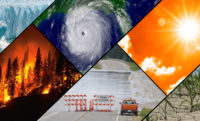
Since the devastating April 25 earthquake in Nepal that killed 7,500 people, the U.S. has provided more than $14.2 million in humanitarian aid. Federal disaster teams were reaching areas made inaccessible by landslides and debris triggered by the tremor that registered a magnitude-7.9. The federal military teams began aerial assessments of the stricken areas, while U.S. representatives met with Nepal government officials and others involved in the disaster response, a State Dept. spokesman said on May 4.
The Nepalese government fears the death toll may rise to well over 10,000.
Other countries, including Japan, Korea, Australia, Israel, France, Switzerland and the UAE, have also pledged millions in humanitarian relief and rescue and recovery personnel.
The devastation in Nepal, particularly in Katmandu, is extensive.
Although the airport is open and flights can get in and out of the country, “communications and transportation remain difficult because of the damage, which is significant,” Rathke said.
Fear of landslides has emerged in Nepal due to aftershocks in the Gorkha district, where the epicenter of the earthquake is located. The steep topography and the high intensity of shaking that was felt may have triggered them, Robert Parker, a researcher with Cardiff University's School of Earth and Ocean Science told the BBC. Landslides in the Himalayan region are known to block the flow of rivers, causing temporary lakes that could burst out, resulting in major loss of life and property.
Chinese rescuers have been airlifting 200 of their compatriots stranded at the Kaligandaki hydroelectricity project, which is about 76 kilometers from the Gorkha district. As of late on April 28, about 25 had been rescued.
There has been no report of damage to any of Nepal’s eight major dam projects: Bhote Koshi, Chilime, Koshi Barrage, Mai, Upper Karnali, West Seti, Kulekhani and Kaligandaki. But fear of aftershocks and landslides remain, and some observers say that inadequate monitoring and communication systems could be a factor in the absence of damage reports.
ISH International Economist Rajiv Biswas estimated that total costs for reconstruction in Nepal could exceed $5 billion, around 20% of its GDP.
Teams on the Ground
The U.S. Agency for International Development is coordinating the response to assess the situation and to provide search and rescue efforts. The agency sent a nearly 130-person disaster-assistance response team to conduct assessments, coordinate humanitarian response and provide search and rescue capabilities.
The team includes two 57-person urban search and rescue crews from Fairfax, Va., and from the Los Angeles County Fire Dept., six rescue dogs that will be incorporated into both teams, and 14 USAID disaster experts.
“We are running round-the-clock operations with the government of Nepal and the international community to account for all residents and to assist in the disaster response,” he said.
Challenges are many in constructing earthquake-proof buildings in Nepal, which lies in the area with the highest quake risk, Zone 5. The major problem is the country’s dire economic condition and serious cash crunch. “It is not just a question of size (of the tremor) but how deep. … In some cities, there is soft soil in certain areas,” said Sudhir Vohra, owner of India-based SV Consultants.
Building retrofits are possible, but there are very few experts nationally, and the process is expensive, said Arvind Nanda, founder and CEO of Interach Building Products, an Indian manufacturer of pre-engineered steel building systems and structures.
“It is the tragedy of poverty. Every country has its own priorities,” he added, noting use of mud or bamboo in poor mountain countries such as Nepal with little access to more modern materials. Nanda noted, however, that some buildings in Katmandu using light steel were not destroyed. "The advantage of steel is that you have to design it, and we incorporate earthquake zones in our designs," he told ENR.
Zia Zafir, a senior principal earthquake engineer at Kleinfelder, says Nepal, like other developing countries, has many
unreinforced masonry buildings that collapse easily in quakes. In rebuilding, builders may look to using local, lightweight materials for housing and other basic structures that, if they collapse, will lessen loss of life.
With tremors felt from the quake in India's Uttar Pradesh state, government officials now are considering stricter rules for high-rise construction, including denying completion certificates to builders who do not incorporate anti-earthquake measures.
Meanwhile, Chinese media are speculating that authorities will re-examine a plan to dig a tunnel through Mount Everest to build a 540-km-long rail line extending China's Lasha railway to the Nepalese border.
Aftershocks and tremors at the mountain triggered deadly avalanches, with more than a dozen mountaineers reported killed. China recently built an airport at the base of its side of Mount Everest to facilitate mountaineers and tourists.
US Seismic Expert on the Ground







Post a comment to this article
Report Abusive Comment